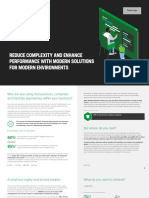0% found this document useful (0 votes)
16 views2 pagesCloud Computing Assignment-4
NGINX is an open-source web server software that serves as a reverse proxy, load balancer, and cache, designed for high performance and stability. It can be configured for various use cases including web serving, API gateways, and DDoS protection. Installation involves updating the package list, installing NGINX, enabling the firewall, and verifying the server status.
Uploaded by
deepakyadav887900Copyright
© © All Rights Reserved
We take content rights seriously. If you suspect this is your content, claim it here.
Available Formats
Download as DOCX, PDF, TXT or read online on Scribd
0% found this document useful (0 votes)
16 views2 pagesCloud Computing Assignment-4
NGINX is an open-source web server software that serves as a reverse proxy, load balancer, and cache, designed for high performance and stability. It can be configured for various use cases including web serving, API gateways, and DDoS protection. Installation involves updating the package list, installing NGINX, enabling the firewall, and verifying the server status.
Uploaded by
deepakyadav887900Copyright
© © All Rights Reserved
We take content rights seriously. If you suspect this is your content, claim it here.
Available Formats
Download as DOCX, PDF, TXT or read online on Scribd
/ 2





























































